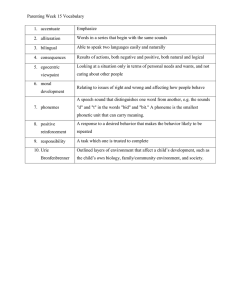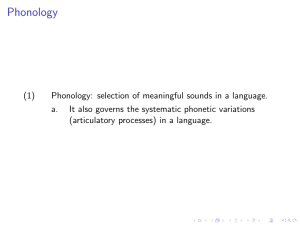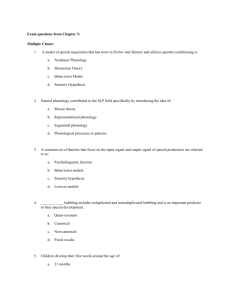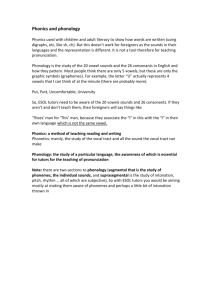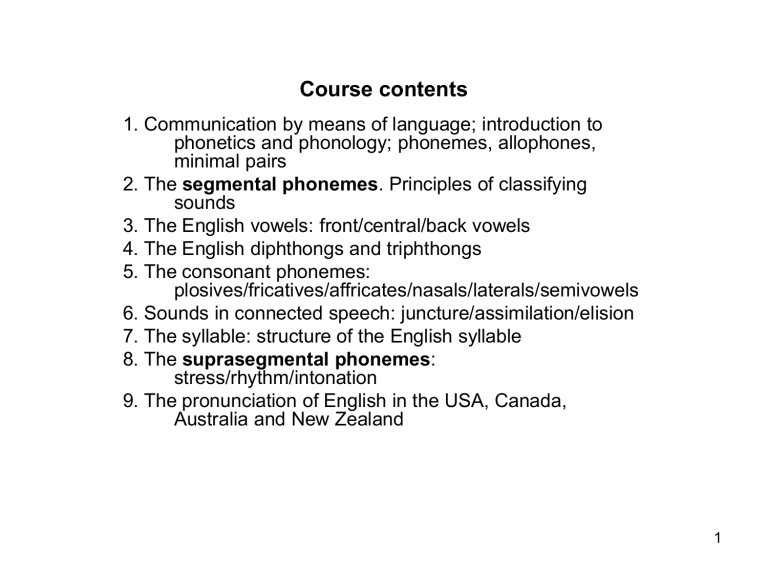
Course contents 1. Communication by means of language; introduction to phonetics and phonology; phonemes, allophones, minimal pairs 2. The segmental phonemes. Principles of classifying sounds 3. The English vowels: front/central/back vowels 4. The English diphthongs and triphthongs 5. The consonant phonemes: plosives/fricatives/affricates/nasals/laterals/semivowels 6. Sounds in connected speech: juncture/assimilation/elision 7. The syllable: structure of the English syllable 8. The suprasegmental phonemes: stress/rhythm/intonation 9. The pronunciation of English in the USA, Canada, Australia and New Zealand 1 I. Introduction 1.1. Language: an introduction 1.2. The role of sound in communication 1.3. Phonemes vs. allophones 1.4. Classification of the phonemes 1.5. Phonetics vs. Phonology 2 1.1. Language: an introduction - language - the most distinctive human characteristic; - language enables us to get in touch with people/places; - language - the link between us, our ancestors and our descendants. 3 Properties of language • -Productivity • -Arbitrarity : Gm. Blume, Rom. floare, Eng. flower. 4 Types of languages a. Sign languages b. Kinesics c. Spoken languages d. Written languages 5 1.2. The role of sound in communication The act of communication can be described in terms of 5 successive operations: SENDER 1. ENCODING 1.1. semantic 1.2. grammatical 1.3. phonological MESSAGE SEMANTICS GRAMMAR PHONOLOGY 2. SENDING→ Artic. phonetics RECEIVER 5. DECODING 5.3. semantic 5.2. grammatical 5.1. phonological Audit.phonetics← 4. RECEPTION 3. TRANSMISSION ↓ Acoustic phonetics 6 Important distinctions 1. Language vs. speech 2. Sounds vs. speech sounds 7 1.3. Phonemes vs. allophones substance (sounds) → Phonetics [k], [s], [i] form (phonemes) → Phonology /kis/, /sik/ EXPRESSION Linguistic item (word) CONTENT substance →Semantics form →Syntax Phonemes – abstract sound segments that change the meaning of words; Allophones – actually produced speech sounds; do not change the meaning of words 8 … continued /t/ = phoneme [ t1] tea [t2] eighth [t3] = allophones train Allophones = realizations of the same phoneme in various contexts 9 … continued Phonologically relevant properties: - Degree of obstruction of the air-flow; - Involvement of the vocal cords - Degree of opening of the mouth cavity; Phonologically irrelevant properties; -linguistically conditioned environments, i.e. the actual wordcontext: e.g. [t] → [t1] in tea; → [t2] in eighth; → [t3] in train -the degree of education of the speaker and his social class: e.g. house pronounced [haus] vs [us]; -age: e.g. door pronounced [d] vs. [d:]; -emphatic speech vs. non-emphatic speech: marvellous vs. ma – a – arvellous. 10 … continued PHONEME - a family of sounds in a given language which are ‘phonetically similar, and do not occur in the same environment’ (Crystal, 1991:258). ALLOPHONE - the actually produced sound. It is a variation of a phoneme. Contributors to the phoneme theory: - Baudouin de Courtenay. - Daniel Jones (1950), The Phoneme: its Nature and Use; main idea: members of the same phoneme are mutually exclusive, since they do not occur in the same position: [ph] in park [pha:k] vs. hiccough [hikp]; shortcoming: he did not consider the long and short vowels to be independent phonemes. Free variation Commutation test Minimal pair Development of allophones into phonemes: f and v, n and ɳ, Ɵ and 11 1.4. Classification of phonemes -segmental phonemes, i.e. phonemes into which larger strings can be segmented (vowels and consonants)- cat is made up of 3 phonemes [kt]; -suprasegmental phonemes - juncture: [ənaishaus] - word-stress: import n. [imp:t], vb. [imp:t]. - intonation: ↑yes vs. ↓yes 12 1.5. Phonetics vs. phonology PHONETICS - the science of speech sounds; interest in this topic quite old: Sanskrit grammarian (Panini, 5th c. BC) – rules for interpreting the Vedic hymns - Importance for foreign language teaching and learning; identifying and correcting speech problems (stuttering, aphasia); -concerned with human sound-making, DESCRIPTION, CLASSIFICATION and TRANSCRIPTION of the speech sounds of a particular language (not all the lgs.) PHONOLOGY - concerned with the range and function of sounds in specific languages. It examines some of the ways sounds are organized and altered in accordance with the rules of the English grammar. In brief: phonetics = the production of speech sounds phonology = the use of speech sounds 13

